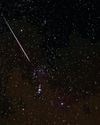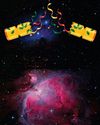試す 金 - 無料
Darkness on the moors
BBC Sky at Night Magazine
|May 2023
In search of true darkness and skies that sparkle, Jamie Carter visits Yorkshire, home of the UK's newest International Dark Sky Reserves

Tonight there's mist on the way to the moors. It creeps through the valley and blots out everything but Venus. But as the minibus climbs up the Sutton Bank escarpment, it begins to clear. By the time we arrive at the North York Moors International Dark Sky Reserve, we're high above the valley mist among heather moorland, low shrubs and stumpy trees. Above us is a big sky with only thin wisps of cloud between the bright stars. The open clusters within Auriga are naked-eye bright and so are the faint suns of Gemini, Taurus and Ursa Minor, all now so elusive from our towns and cities.
"Does anyone know, what is the furthest thing it's possible to see with the naked eye?" says astronomer Richard Darn, our host for the evening. "The Moon?" says a voice from the dark. "A nebula?" asks another. The Andromeda Galaxy, 2.5 million lightyears from Earth, is soon picked out with a green laser. It's waiting in the crosshairs of a Takahashi refractor for all to inspect. It's an exciting moment for many. In its wake comes the equally crowd-pleasing Pleiades, the Orion Nebula, the M81 and M82 galaxies, double star Almach, and a waning comet, C/2022 E3. The views are delivered crisply and quickly, but some guests seem happy just to stare at a 'blanket of stars' they've heard much about but rarely seen.
Nightseeing trip
このストーリーは、BBC Sky at Night Magazine の May 2023 版からのものです。
Magzter GOLD を購読すると、厳選された何千ものプレミアム記事や、10,000 以上の雑誌や新聞にアクセスできます。
すでに購読者ですか? サインイン
BBC Sky at Night Magazine からのその他のストーリー

BBC Sky at Night Magazine
How to photograph the Geminids
Dramatic meteor photos aren't just down to luck. We show you how to bag one
3 mins
December 2025

BBC Sky at Night Magazine
10 Christmas crackers for your new telescope
So Santa brought you a telescope - what now? Stuart Atkinson sprinkles some cosmic sparkle, with 10 sights to see over one fabulous festive night - from glorious galaxies and planets to glittering star clusters
7 mins
December 2025

BBC Sky at Night Magazine
10 years of reusable rockets
Ben Evans charts the rise of multi-flight spacecraft, the tech revolution that's transforming our access to space
6 mins
December 2025

BBC Sky at Night Magazine
SKILLS FOR STARGAZERS
Take great photos of the Milky Way
3 mins
December 2025

BBC Sky at Night Magazine
Smart scopes: from backyard to big science
Home-based stargazers are helping scientists crack some of the Universe's big mysteries - and you can join them. Charlotte Daniels shows us how
6 mins
December 2025

BBC Sky at Night Magazine
FIELD OF VIEW
Forget Instagram – embrace the moment
2 mins
December 2025

BBC Sky at Night Magazine
Q&A WITH A PLANETARY LIFE EXPERT
Saturn's icy moon Enceladus boasts water, heat and organics. Now scientists have discovered it has complex chemistry too. Could it prove to be habitable?
3 mins
December 2025

BBC Sky at Night Magazine
INSIDE THE SKY AT NIGHT
When The Sky at Night joined Curious Cases for a special episode, George Dransfield was there to answer your burning questions. Here she dives deeper into her favourite
3 mins
December 2025

BBC Sky at Night Magazine
Students fix JWST's blurry vision
PhD researchers restore the telescope's ultra-precise imaging - without a spacewalk
1 min
December 2025

BBC Sky at Night Magazine
On a Mission
This is an inspiring tribute to the trailblazing women who shaped NASA's human spaceflight programmes.
1 mins
December 2025
Translate
Change font size

